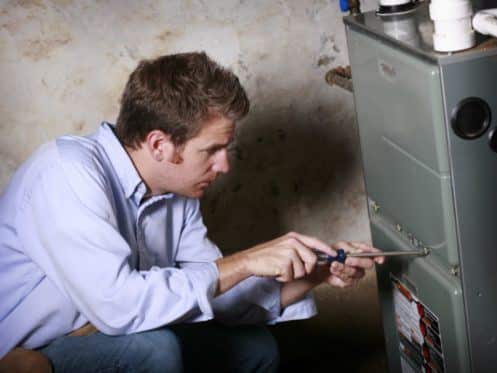Do You Know How Long Your Gas Furnace Should Last?

When it comes to heating your home through the winter, gas furnaces have been the standard appliance for decades. While they last a long time, they do wear out and need a replacement at some point. Discover how long your furnace should last, the factors that will affect its longevity, and how you know when it’s time for a replacement.
General Rule for Service Life
When it comes to gas furnaces, the general rule of thumb is that they should last roughly 15 to 20 years. In the Houston area, they may actually last longer due to the mild winter temperatures and not needing to run them constantly.
Even though they may not see as much use as their counterparts farther north, you still want to replace them after about 20 years. Furnace technology is constantly evolving, which improves its efficiency. Once your unit is 20 years old, it’s likely that new models are more efficient than the unit you installed two decades prior.
Further, as your unit ages, it slowly loses efficiency compared to when it was new. This happens because of both airflow restrictions in the unit and system components wearing out, leading to suboptimal and less efficient operation.
Critical Furnace Parts
While there are many small parts that make up your furnace, there are a few that are critical to giving your unit a long life. When these have a problem, they can add exceptional strain to the system, reducing its expected service life.
The thermostat acts as your furnace’s brain, signaling when it should fire up and shut down. However, the thermostat won’t last forever, usually working accurately for 10 to 15 years. Once it gets beyond this age, it may start registering an improper temperature, potentially causing short cycling or long heating cycles. Either adds work to the system, reducing its service life.
The igniter and burner work together to produce the heat within the furnace. When they don’t work, your furnace may not ignite. However, some problems with the furnace may actually cause an overheating situation, which will add wear across the system, but especially to the heat exchanger.
The heat exchanger is what transfers the heat from the hot exhaust to the air circulating through the system. When this gets overheated, it can cause the metal to become weak and crack. A cracked heat exchanger is extremely dangerous, leading to carbon monoxide leaking into your home.
Finally, the blower motor is responsible for pulling cool air into the system and then pushing heated air back out. When this fails, it may not spin as quickly, or it could refuse to start at all. The result is less heating in your home, plus too much heat building up in the unit.
How Size Impacts Service Life
Installing the right size furnace in your home affects the potential service life. If you get an oversized system, it will overheat and short cycle. This weakens the heat exchanger and adds a lot of wear to the electrical components.
Conversely, an undersized system will run long heating cycles. When you think about service life, consider it as available service hours. When you have long heating cycles, you use more of those service hours more quickly, reducing the number of years the equipment will run.
Why Installation Matters So Much
It’s important that the furnace and its supportive components are all installed properly. According to some industry analysts, as many as 90% of furnaces may be improperly installed. This could include the furnace itself, the fuel line, or the ducts. At a minimum, improper installation reduces efficiency, causing a service life reduction. However, some installation mistakes can create a dangerous situation for you and your family.
The Importance of Airflow
Your system depends on pulling in and circulating the right amount of air to maintain its efficiency. There are two primary ways your system will experience airflow restrictions, both of which are preventable.
A clogged air filter is the first and easiest to prevent. Check your filter monthly, and replace it when it becomes noticeably dirty. For flat 1- and 2-inch filters, this may be as frequently as every 30 days. However, pleated 5- and 6-inch filters may last as much as half a year, depending on your air quality. Check with your technician for the recommended replacement schedule for your filter size and style.
Your Usage Habits May Reduce Service Life
Your furnace’s set temperature and the use of programs will also affect your unit’s service life. Keeping your furnace set too high will make it work harder than necessary, reducing its life expectancy. The Department of Energy suggests the ideal temperature over the winter is 68 degrees Fahrenheit.
You can reduce the strain by lowering the temperature while you’re not home. Keeping it a few degrees cooler will reduce the wear on your system, not to mention reducing your annual heating costs by up to 10%.Here are a few other heating tips.
The Ductwork May Knock Years Off
If you don’t take care of your duct work, you could knock years off your furnace’s life because of reduced efficiency. First, your ducts need to remain properly sealed and insulated to keep the efficiency at its peak. Ducts tend to develop leaks over time, which prevents the right air pressure from flowing from the vents, reducing the air circulating around your home. This makes your system run longer cycles.
Additionally, if you don’t have your ducts cleaned periodically, it will cause an airflow restriction within them. Ideally, plan to have your ducts cleaned every few years.
Do You Allow Small Problems to Linger?
Small problems with your furnace can compound over time. Something that might seem like a small problem might be an unusual noise, not quite enough air coming from your vents, or air that’s not adequately heated. All of these point to an issue that will reduce your efficiency and increase strain. The longer you allow these problems to persist, the more severe the repairs will become, and the more life will be stolen from your furnace.
How Do You Know It’s Time for a New Furnace?
There are three primary ways to know when it’s time to replace your furnace. The first is simply keeping track of its age and replacing it sometime between 15 and 20 years. Anyone who doesn’t want to deal with an emergency replacement takes this route, even if the current unit appears to still run well.
Next, consider your energy consumption. As your furnace ages, you’ll notice that it consistently consumes more energy each month compared to the year prior. While some malfunctions may cause this increase as well, combine the increase with your system’s age, and you’ll have a good indicator.
Likewise, keep an eye on the number and cost of repairs you have each year. Add up the repairs from the prior two years and multiply that by the age of your furnace. If this exceeds the cost of a new unit, it’s time to consider your replacement.
Trust the company that people around Houston have turned to keep them comfortable for over 60 years. Our expert technicians at The Lee Thompson Co. provide heating and air conditioning installation, maintenance, and repair along with indoor air quality solutions for homes of all sizes. Call to schedule your consultation with one of our friendly furnace installs specialists today.

